| UNITED STATES |
| SECURITIES AND EXCHANGE COMMISSION |
| Washington, D.C. 20549 |
| |
FORM N-CSR |
| |
CERTIFIED SHAREHOLDER REPORT OF REGISTERED |
MANAGEMENT INVESTMENT COMPANIES |
| |
| |
| |
| Investment Company Act File Number: 811-4998 |
|
| |
| T. Rowe Price Spectrum Fund, Inc. |
|
| (Exact name of registrant as specified in charter) |
| |
| 100 East Pratt Street, Baltimore, MD 21202 |
|
| (Address of principal executive offices) |
| |
| David Oestreicher |
| 100 East Pratt Street, Baltimore, MD 21202 |
|
| (Name and address of agent for service) |
| |
| |
| Registrant’s telephone number, including area code: (410) 345-2000 |
| |
| |
| Date of fiscal year end: December 31 |
| |
| |
| Date of reporting period: December 31, 2009 |
Item 1: Report to Shareholders| Spectrum Funds | December 31, 2009 |

The views and opinions in this report were current as of December 31, 2009. They are not guarantees of performance or investment results and should not be taken as investment advice. Investment decisions reflect a variety of factors, and the managers reserve the right to change their views about individual stocks, sectors, and the markets at any time. As a result, the views expressed should not be relied upon as a forecast of the fund’s future investment intent. The report is certified under the Sarbanes-Oxley Act, which requires mutual funds and other public companies to affirm that, to the best of their knowledge, the information in their financial reports is fairly and accurately stated in all material respects.
REPORTS ON THE WEB
Sign up for our E-mail Program, and you can begin to receive updated fund reports and prospectuses online rather than through the mail. Log in to your account at troweprice.com for more information.
Manager’s Letter
Fellow Shareholders
Global financial markets continued to improve over the past six months, with emerging markets leading the way. Substantial stimulus measures enacted by governments and multiple efforts by central banks to ease monetary policy enabled companies and consumers to repair balance sheets. Corporate earnings surprised on the upside, and while consumer spending in the developed world, particularly in the U.S., continued to wane, unmistakable signs of growth appeared. However, many economies remain fragile, with high unemployment likely to persist for much of the year. Each of the Spectrum Funds posted strong gains in both periods.
MARKET ENVIRONMENT
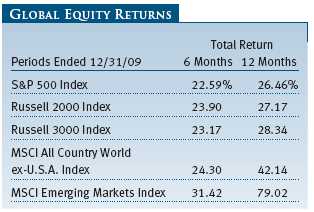
In contrast to the steady drumbeat of bad economic news into early 2009, the past several quarters have seen a resurgence of confidence among investors that economic growth is at hand. The global downturn is hardly a thing of the past. In its wake, deficit spending has accelerated; unemployment is at extraordinary levels; and lending, which is essential to economic growth, remains anemic. At least, that’s the story in much of the developed world. Meanwhile, emerging economies are in a different zone. From Brazil to China, economic conditions have improved markedly since the collapse in confidence that wrecked stock markets a short time ago. They have rebounded sharply in the last year, with some emerging markets stock indexes having climbed more than 100% since their March 2009 lows.
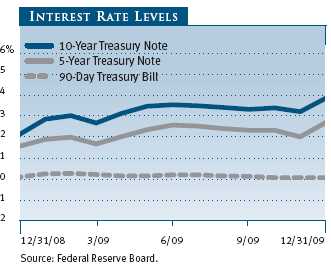
U.S. stocks gained in the second half of 2009 amid improved investor sentiment. Large-cap shares slightly trailed their small-cap peers, but mid-cap stocks trumped both segments. As measured by various Russell indexes, value stocks narrowly outpaced growth among large-cap shares, but growth stocks trumped value in the small- and mid-cap universe. In the large-cap universe, shares of information technology companies produced superior returns, thanks to attractive valuations, aggressive cost-cutting, cash-rich balance sheets, and better-than-expected revenues. Consumer discretionary and industrials and business services stocks also did very well, as investors anticipated that these sectors would benefit substantially from an economic recovery while materials stocks climbed with commodity prices. Utilities and telecommunication services—two sectors often perceived as safe havens in an economic downturn—lagged with modest gains.
Foreign stocks in developed markets slightly trailed U.S. shares in the second half of 2009, as a late-year rally in the U.S. dollar versus other currencies dampened returns in dollar terms. Shares in Europe fared well, but Japanese shares trailed significantly. Emerging markets outperformed developed markets, led by equities in Latin America and emerging Europe.
U.S. bonds produced positive returns in the last six months, as credit market conditions continued to improve and money market yields near 0% prompted yield-hungry investors to seek riskier securities with an income advantage. High yield bonds fared best and produced excellent returns as credit spreads narrowed significantly, but investment-grade corporate bonds also gained. Asset-backed securities—which are backed by credit card, auto loan, or other debt payments—benefited from increased demand through the Federal Reserve’s Term Asset-Backed Securities Loan Facility. U.S. Treasury securities were mostly flat as longer-term interest rates rose amid signs of an economic recovery and heavy new issuance.
Non-U.S. bonds produced positive returns in the last six months. Emerging markets debt did very well, as investors seeking higher yields returned to riskier asset classes. High-quality bonds issued in developed countries were tempered by the U.S. dollar’s late-year rally versus other currencies.
SPECTRUM GROWTH FUND
The Spectrum Growth Fund returned 24.61% for the six months ended December 31, 2009, and 40.94% for the full year. The fund outperformed the Russell 3000 Index and the Lipper Multi-Cap Core Funds Index for both periods.
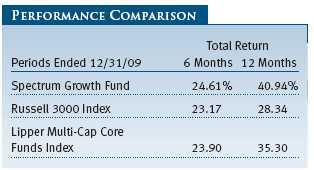
Each of Spectrum Growth’s underlying components posted positive returns in the last six months. The fund’s large-cap holdings—Growth Stock Fund, Value Fund, Equity Income Fund, and Blue Chip Growth Fund—turned in solid gains. The fund remains neutral between growth and value, as the value segment could benefit as corporate earnings prospects begin to improve. We are underweight to small-cap stocks as valuations favor large-cap stocks.
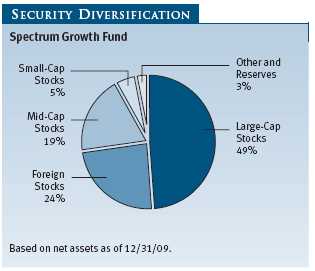
We are modestly overweight in non-U.S. equity markets, both developed and emerging relative to U.S. equities, based on more attractive valuations overseas. We have moved to overweight the emerging markets equity sector based on the promising intermediate- to longer-term outlook for growth. Over a longer investment horizon, greater growth opportunities should offset higher interim volatility.
SPECTRUM INCOME FUND
The Spectrum Income Fund returned 11.17% for the six months ended December 31, 2009, and 20.29% for the full year, outperforming the Barclays Capital U.S. Aggregate Index and the Lipper General Bond Funds Average for both periods (see the accompanying performance table).
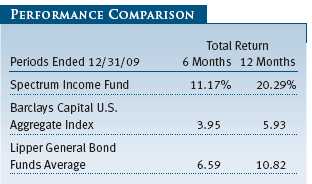
While the fund is predominantly a fixed income portfolio, our third-largest holding is the Equity Income Fund, which invests in dividend-paying stocks. We maintain a strong weighting to equities in order to benefit from the long-term appreciation potential of stocks, as well as to lower the portfolio’s sensitivity to changes in interest rates. In the last six months, the Equity Income Fund, which invests in large-cap value stocks, was the top fund performer, as it benefited from the strong rebound in U.S. equity prices over the last six and 12 months.
Among fixed income securities, the High Yield Fund generated outstanding gains amid improving liquidity. High yield bonds have easily outperformed the broad bond market thanks primarily to declining default risk, the improving economic outlook, and ample liquidity. Within the asset class, the lowest-rated credits outperformed higher-quality B and BB rated bonds. Narrowing credit spreads and investor demand for higher income spurred the performance of high yield bonds. The New Income Fund, the fund’s largest position, also produced solid returns due to the strong performance of credit-sensitive investment-grade corporate bonds.
Other positive performers within the portfolio included the International Bond Fund and the Emerging Markets Bond Fund, each of them benefiting from increased appetite for risk, improved liquidity, and positive cash flows. The International Monetary Fund continued to provide much-needed assistance for emerging markets issuers in need of external financing. We remain positive with regard to this asset class.
The Corporate Income Fund produced solid returns due to improved credit conditions and the ability of firms to issue new debt. We have increased our position in the fund as valuations in the corporate bond market have become more attractive. The Short-Term Bond Fund performed well early in the year but lost ground in the second half. Signs of an economic recovery and heavy new issuance pushed U.S. Treasuries’ longer-term rates higher, but Treasuries were mostly flat. The GNMA Fund contributed modestly to fund performance. While the fund produced solid returns early in the year, reflecting the high-quality mortgage-backed securities, it deteriorated late in the period. We reduced our allocation to mortgage-backed securities, which form a significant portion of the domestic bond market. We are concerned about valuations, which have been driven higher by Fed purchases, as well as the prospect of the Fed discontinuing its purchases, which would remove the primary buyer from the market.
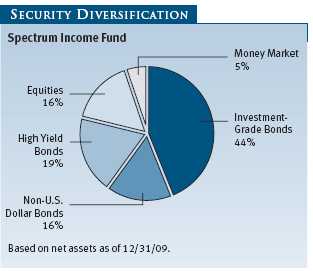
SPECTRUM INTERNATIONAL FUND
The Spectrum International Fund returned 24.30% for the six months ended December 31, 2009, and 44.99% for the full year. The fund outperformed the Lipper International Multi-Cap Core Funds Average and was in line with our new primary benchmark, the MSCI All Country World ex-U.S.A. Index for the last six months. For the full year, the fund outperformed its benchmarks. The fund recovered much of the devastating losses of 2008, but it remains below its 2007 highs.
We are also showing the linked performance benchmark, which illustrates a previous index in the fund (please see the performance table for a breakdown of the index) and the MSCI benchmark that became effective on March 1, 2009. The new MSCI benchmark more accurately reflects the investment strategy of the fund, with its emphasis on non-U.S. equities in both developed and emerging markets.
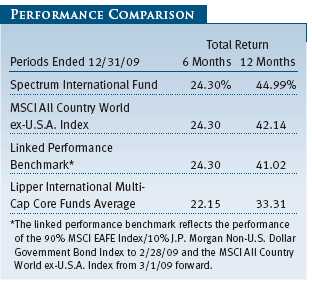
Every component of the portfolio advanced in the last six months. In general, the Spectrum International Fund benefited from the resurgence in global equities following the staggering worldwide collapse that appeared to reach its nadir in March 2009. Bargain hunters scooped up shares of deeply discounted developed markets stocks, as it became clearer that policymakers were intent upon rescuing their financial systems and that the worst economic meltdown since the Great Depression was gradually coming to an end. The story in the emerging world was even more encouraging, and, in this universe, our New Asia Fund and Emerging Markets Stock Fund had exceptional returns. Each of them returned more than 80% for the full year, recovering much of the earlier devastating losses.
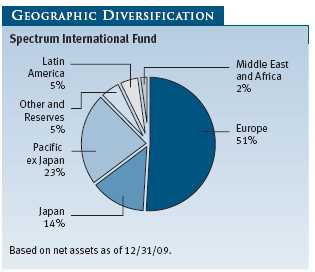
Many of the economies in the developing world, from China to Brazil, attacked the financial mess quickly and aggressively with monetary easing and fiscal stimulus. Equally important, these countries rebounded strongly because the myriad problems facing developed markets were in short supply and because these countries have good structural economic engines. Their banks are busy lending, their companies are succeeding at increasing exports, and consumer growth is moving apace. These factors contributed to their ability to rapidly rebound from the economic disaster that struck first in the developed world.
Over the period, we increased our holdings in the Emerging Markets Stock Fund and the New Asia Fund. Despite the enormous gains in 2009, we think the emerging world, and Asia especially, stand to benefit from the healthy economic growth in place over the long term. We also added to our allocation in International Growth & Income, which invests in companies from established countries in developed markets. We believe they are currently undervalued.
OUTLOOK
Markets around the world have amassed huge gains since the first quarter of 2009. The Fed and other central banks, as well as governments, stepped up their efforts to buttress struggling economies. Since then, credit markets have gradually improved, manufacturing has rebounded, and corporate profits have surprised on the upside. That said, this recovery is likely to be long and uneven as corporate profits cannot forever be dependent on cost-cutting measures and a depletion of inventories.
Valuations have rapidly returned to near-normal levels. There are many companies that our managers believe are undervalued and whole sectors or even regions that could benefit from a gradual global economic recovery. But the gains of the past year, even after the devastating losses of 2008 and 2009, are unlikely to be repeated. Going forward, the seeds of recovery should bear fruit. But the headwinds we still face—a continued housing slump in much of the developed world, huge government deficits, and the prospect of rampant inflation—are potentially very serious.
We believe that shareholders will be well served over the long term by the funds’ fundamental commitment to diversification across asset classes as well as our emphasis on strong fundamental research in seeking investment opportunities in the current market environment.
Respectfully submitted,

Edmund M. Notzon III
President of the Spectrum Funds and chairman of the Investment Advisory Committee
January 20, 2010
The committee chairman has day-to-day responsibility for managing the portfolios and works with committee members in developing and executing the funds’ investment program.
RISKS OF INVESTING
As with all stock and bond mutual funds, each fund’s share price can fall because of weakness in the stock or bond markets, a particular industry, or specific holdings. Stock markets can decline for many reasons, including adverse political or economic developments, changes in investor psychology, or heavy institutional selling. The prospects for an industry or company may deteriorate because of a variety of factors, including disappointing earnings or changes in the competitive environment. In addition, the investment manager’s assessment of companies held in a fund may prove incorrect, resulting in losses or poor performance even in rising markets.
Bonds are subject to interest rate risk, the decline in bond prices that usually accompanies a rise in interest rates, and credit risk, the chance that any fund holding could have its credit rating downgraded or that a bond issuer will default (fail to make timely payments of interest or principal), potentially reducing the fund’s income level and share price. High yield corporate bonds could have greater price declines than funds that invest primarily in high-quality bonds. Companies issuing high yield bonds are not as strong financially as those with higher credit ratings, so the bonds are usually considered speculative investments.
Funds that invest overseas may carry more risk than funds that invest strictly in U.S. assets. Risks can result from varying stages of economic and political development; differing regulatory environments, trading days, and accounting standards; and higher transaction costs of non-U.S. markets. Non-U.S. investments are also subject to currency risk, or a decline in the value of a foreign currency versus the U.S. dollar, which reduces the dollar value of securities denominated in that currency.
GLOSSARY
Barclays Capital U.S. Aggregate Index: An unmanaged index that tracks investment-grade corporate and government bonds.
J.P. Morgan Non-U.S. Dollar Government Bond Index: An unmanaged index that tracks the performance of major non-U.S. bond markets.
Lipper indexes: Fund benchmarks that consist of a small number of the largest mutual funds in a particular category as tracked by Lipper Inc.
MSCI All Country World ex-U.S.A. Index: An index that measures equity market performance of developed and emerging countries, excluding the U.S.
MSCI EAFE Index: An unmanaged index that tracks the stocks of about 1,000 companies in Europe, Australasia, and the Far East (EAFE).
MSCI Emerging Markets Index: An unmanaged index that tracks stocks in 26 emerging market countries.
Russell 2000 Index: An unmanaged index that tracks the stocks of 2,000 small U.S. companies.
Russell 3000 Index: An index that tracks the performance of the 3,000 largest U.S. companies, representing approximately 98% of the investable U.S. equity market.
S&P 500 Index: An unmanaged index that tracks the stocks of 500 U.S. primarily large-cap companies.
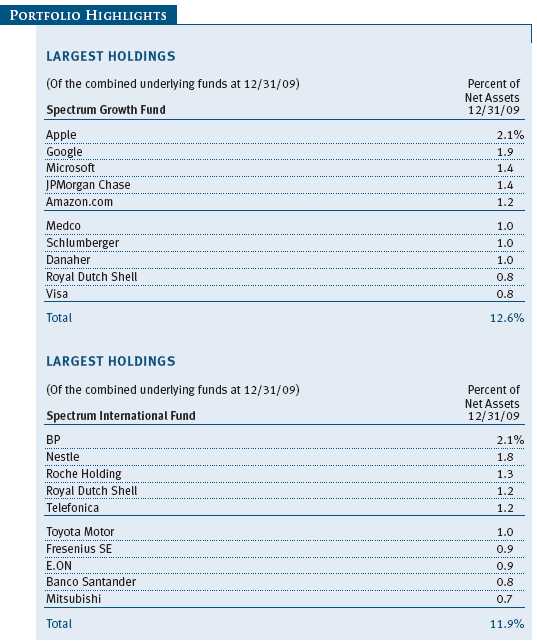
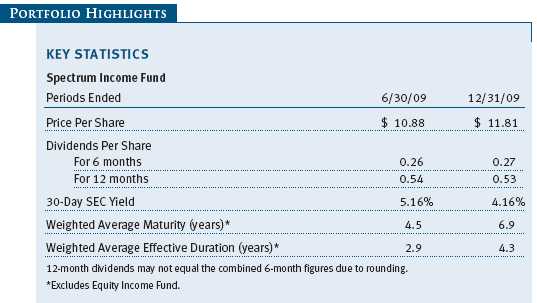
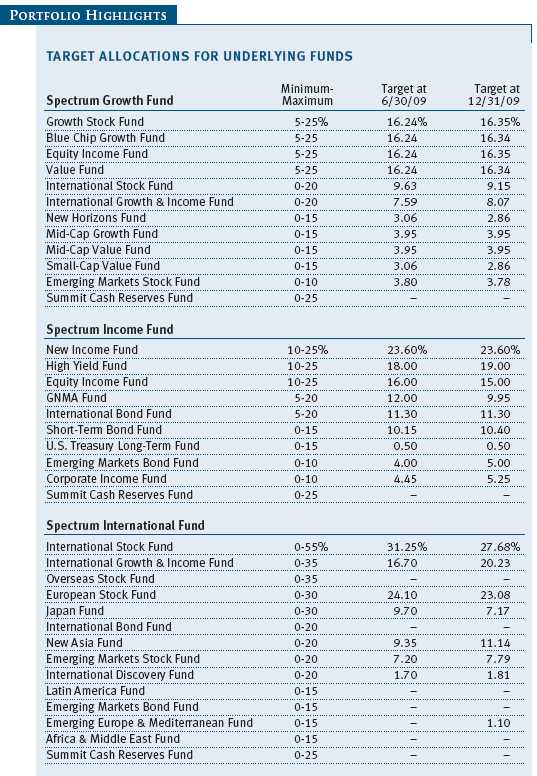
Performance and Expenses
This chart shows the value of a hypothetical $10,000 investment in the fund over the past 10 fiscal year periods or since inception (for funds lacking 10-year records). The result is compared with benchmarks, which may include a broad-based market index and a peer group average or index. Market indexes do not include expenses, which are deducted from fund returns as well as mutual fund averages and indexes.
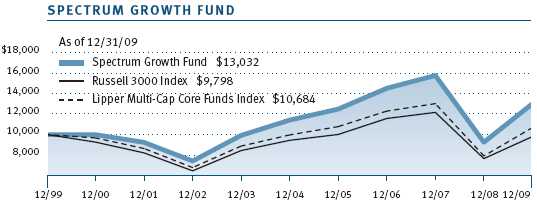
| AVERAGE ANNUAL COMPOUND TOTAL RETURN |
This table shows how the fund would have performed each year if its actual (or cumulative) returns had been earned at a constant rate.
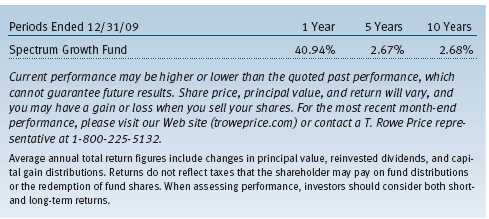
This chart shows the value of a hypothetical $10,000 investment in the fund over the past 10 fiscal year periods or since inception (for funds lacking 10-year records). The result is compared with benchmarks, which may include a broad-based market index and a peer group average or index. Market indexes do not include expenses, which are deducted from fund returns as well as mutual fund averages and indexes.
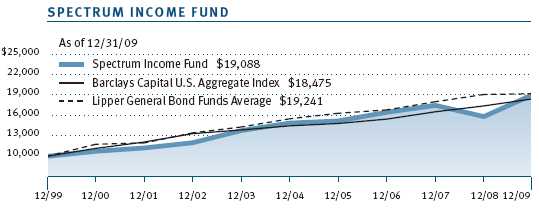
| AVERAGE ANNUAL COMPOUND TOTAL RETURN |
This table shows how the fund would have performed each year if its actual (or cumulative) returns had been earned at a constant rate.
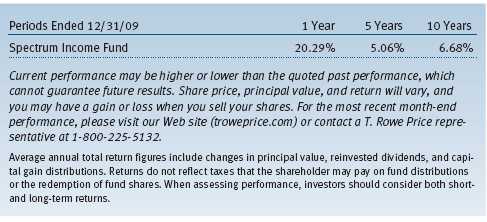
This chart shows the value of a hypothetical $10,000 investment in the fund over the past 10 fiscal year periods or since inception (for funds lacking 10-year records). The result is compared with benchmarks, which may include a broad-based market index and a peer group average or index. Market indexes do not include expenses, which are deducted from fund returns as well as mutual fund averages and indexes.
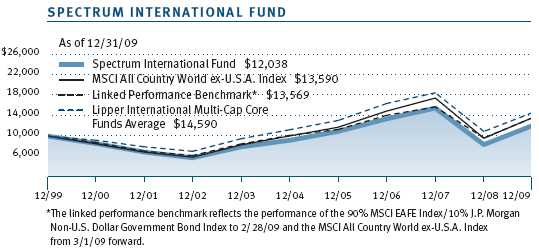
| AVERAGE ANNUAL COMPOUND TOTAL RETURN |
This table shows how the fund would have performed each year if its actual (or cumulative) returns had been earned at a constant rate.
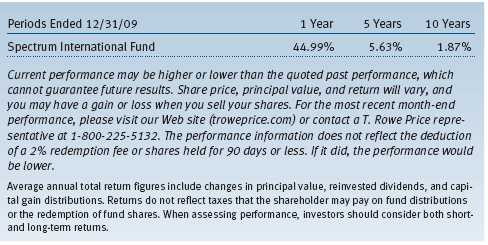

As a mutual fund shareholder, you may incur two types of costs: (1) transaction costs, such as redemption fees or sales loads, and (2) ongoing costs, including management fees, distribution and service (12b-1) fees, and other fund expenses. The following example is intended to help you understand your ongoing costs (in dollars) of investing in the fund and to compare these costs with the ongoing costs of investing in other mutual funds. The example is based on an investment of $1,000 invested at the beginning of the most recent six-month period and held for the entire period.
Actual Expenses
The first line of the following table (“Actual”) provides information about actual account values and expenses based on the fund’s actual returns. You may use the information in this line, together with your account balance, to estimate the expenses that you paid over the period. Simply divide your account value by $1,000 (for example, an $8,600 account value divided by $1,000 = 8.6), then multiply the result by the number in the first line under the heading “Expenses Paid During Period” to estimate the expenses you paid on your account during this period.
Hypothetical Example for Comparison Purposes
The information on the second line of the table (“Hypothetical”) is based on hypothetical account values and expenses derived from the fund’s actual expense ratio and an assumed 5% per year rate of return before expenses (not the fund’s actual return). You may compare the ongoing costs of investing in the fund with other funds by contrasting this 5% hypothetical example and the 5% hypothetical examples that appear in the shareholder reports of the other funds. The hypothetical account values and expenses may not be used to estimate the actual ending account balance or expenses you paid for the period.
Note: T. Rowe Price charges an annual small-account maintenance fee of $10, generally for accounts with less than $2,000 ($500 for UGMA/UTMA). The fee is waived for any investor whose T. Rowe Price mutual fund accounts total $25,000 or more, accounts employing automatic investing, and IRAs and other retirement plan accounts that utilize a prototype plan sponsored by T. Rowe Price (although a separate custodial or administrative fee may apply to such accounts). This fee is not included in the accompanying table. If you are subject to the fee, keep it in mind when you are estimating the ongoing expenses of investing in the fund and when comparing the expenses of this fund with other funds.
You should also be aware that the expenses shown in the table highlight only your ongoing costs and do not reflect any transaction costs, such as redemption fees or sales loads. Therefore, the second line of the table is useful in comparing ongoing costs only and will not help you determine the relative total costs of owning different funds. To the extent a fund charges transaction costs, however, the total cost of owning that fund is higher.
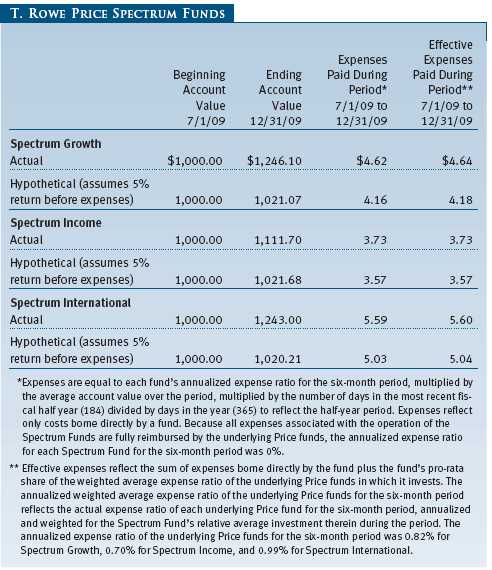
T. ROWE PRICE SPECTRUM GROWTH FUND
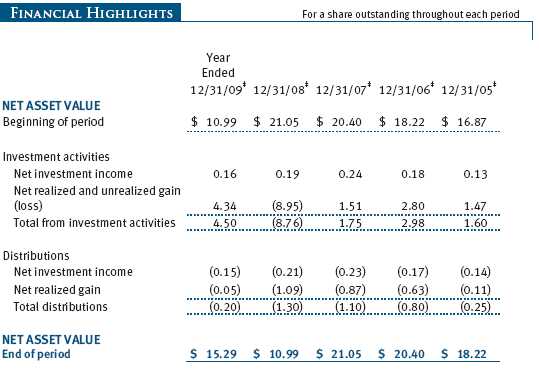
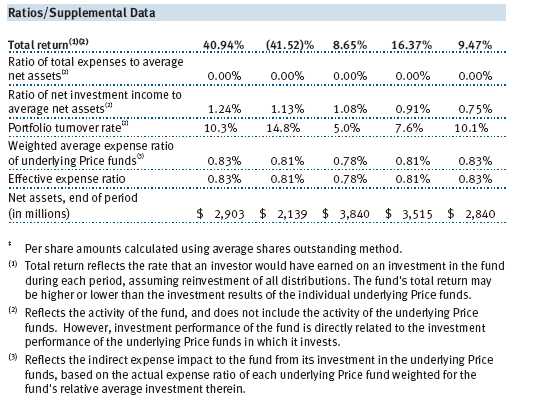
The accompanying notes are an integral part of these financial statements.
T. ROWE PRICE SPECTRUM INCOME FUND
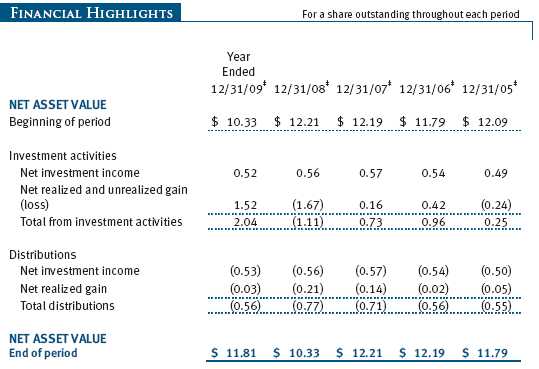
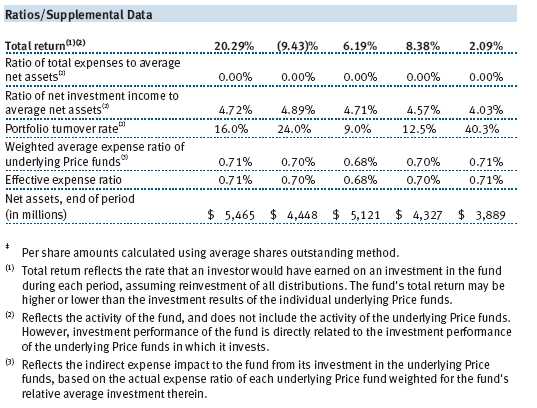
The accompanying notes are an integral part of these financial statements.
T. ROWE PRICE SPECTRUM INTERNATIONAL FUND
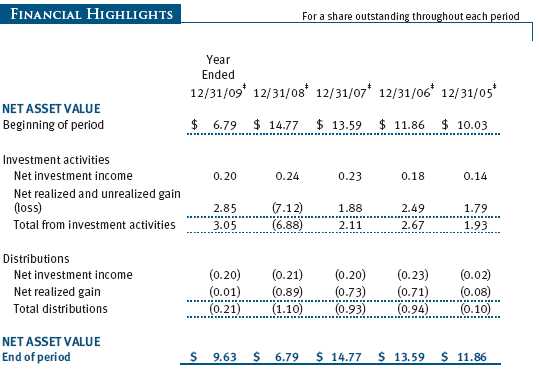
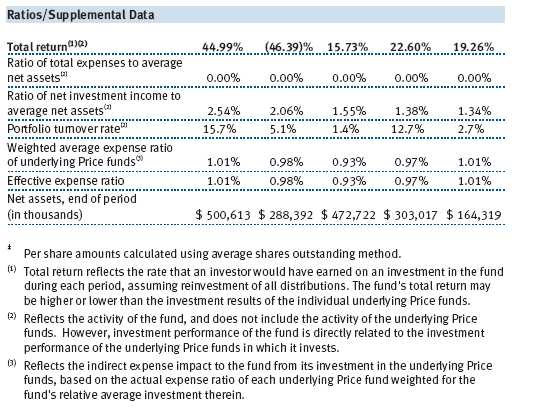
The accompanying notes are an integral part of these financial statements.
T. ROWE PRICE SPECTRUM GROWTH FUND
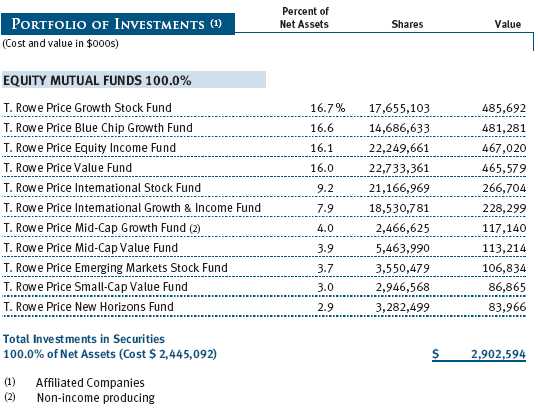
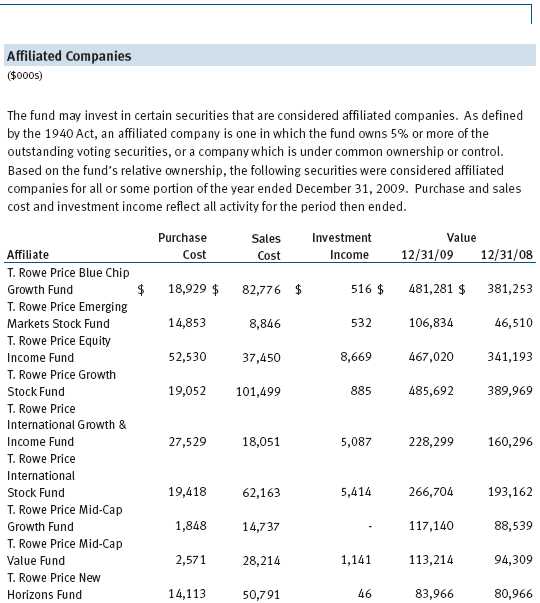
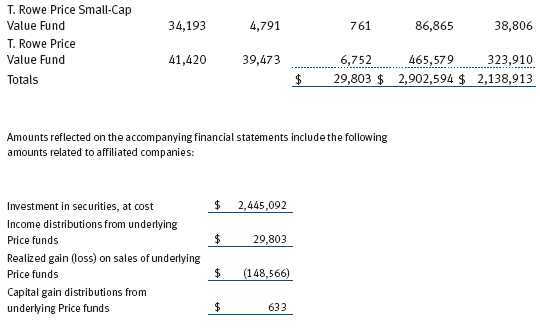
The accompanying notes are an integral part of these financial statements.
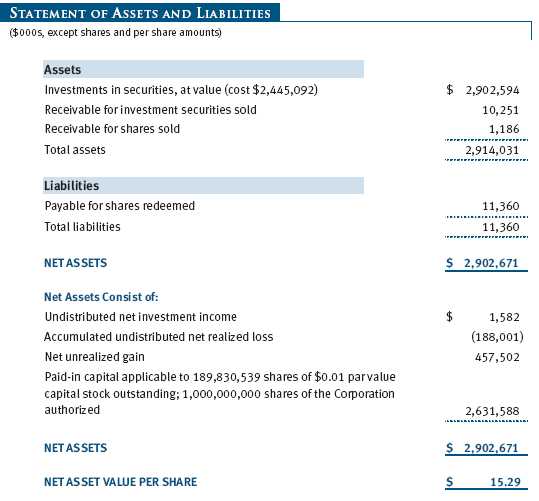
The accompanying notes are an integral part of these financial statements.
T. ROWE PRICE SPECTRUM INCOME FUND
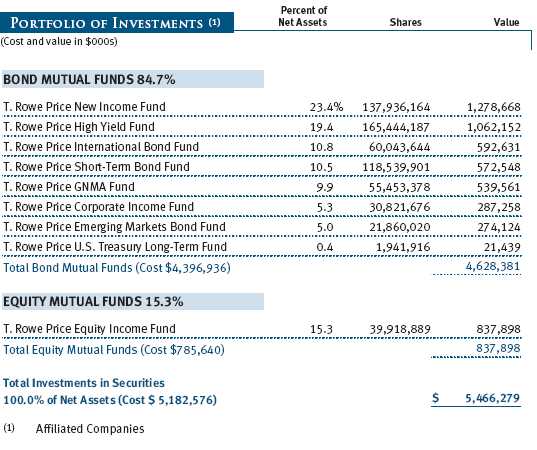
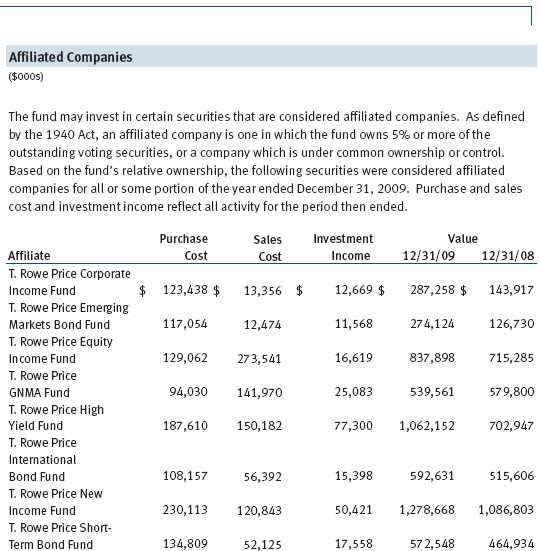
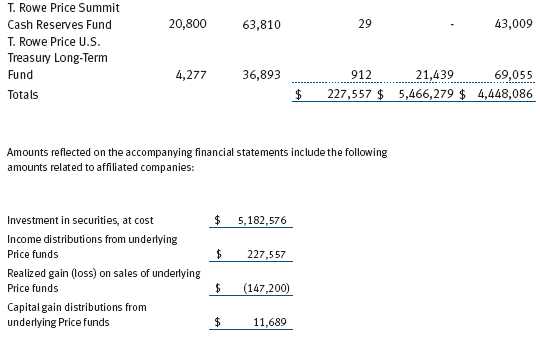
The accompanying notes are an integral part of these financial statements.
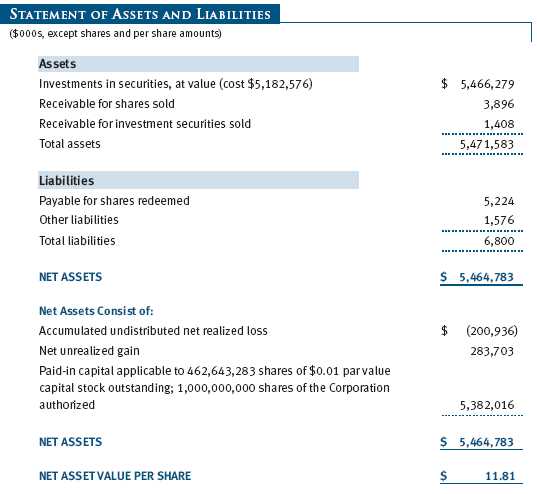
The accompanying notes are an integral part of these financial statements.
T. ROWE PRICE SPECTRUM INTERNATIONAL FUND
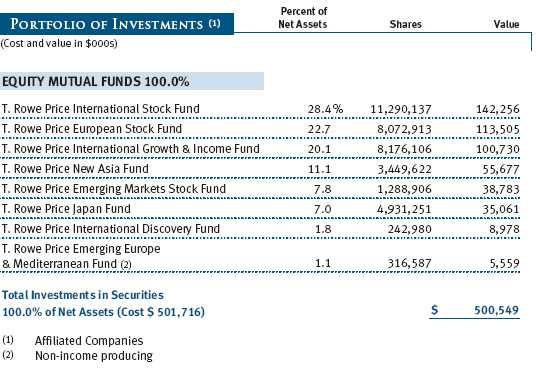
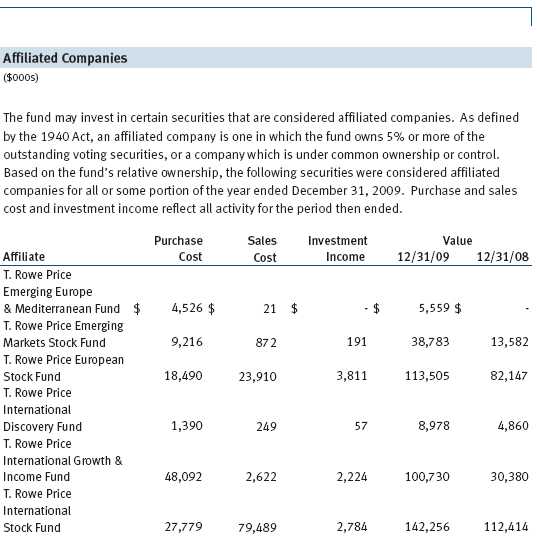
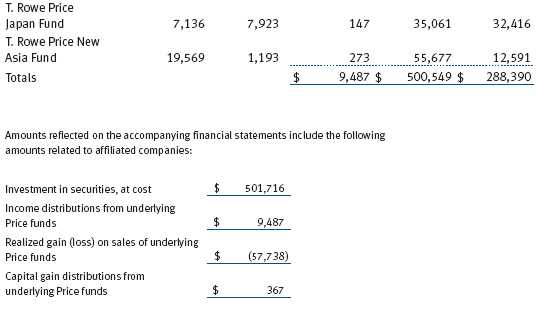
The accompanying notes are an integral part of these financial statements.
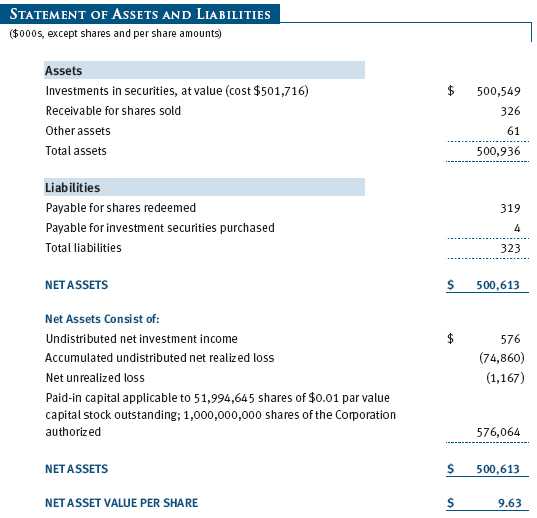
The accompanying notes are an integral part of these financial statements.
T. ROWE PRICE SPECTRUM GROWTH FUND
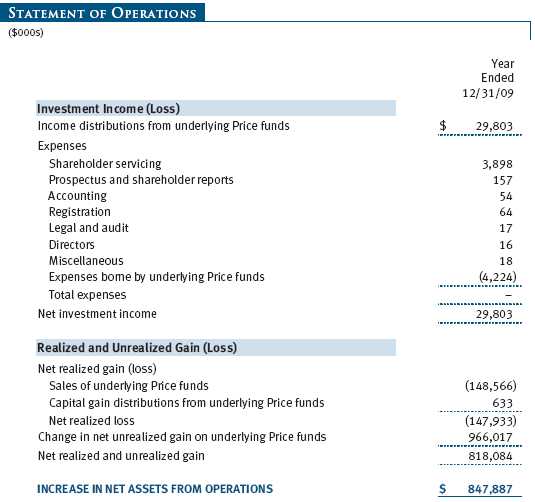
The accompanying notes are an integral part of these financial statements.
T. ROWE PRICE SPECTRUM INCOME FUND
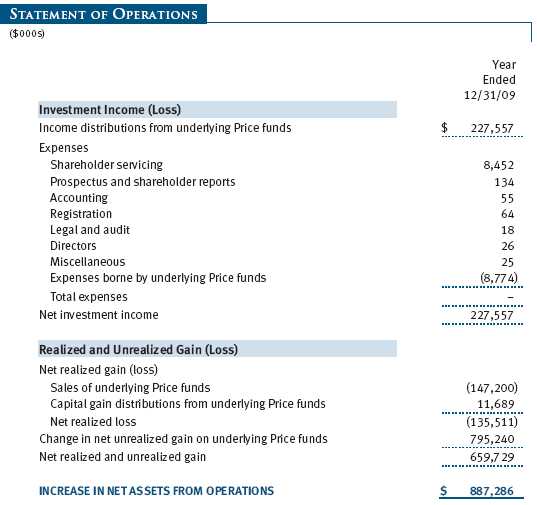
The accompanying notes are an integral part of these financial statements.
T. ROWE PRICE SPECTRUM INTERNATIONAL FUND
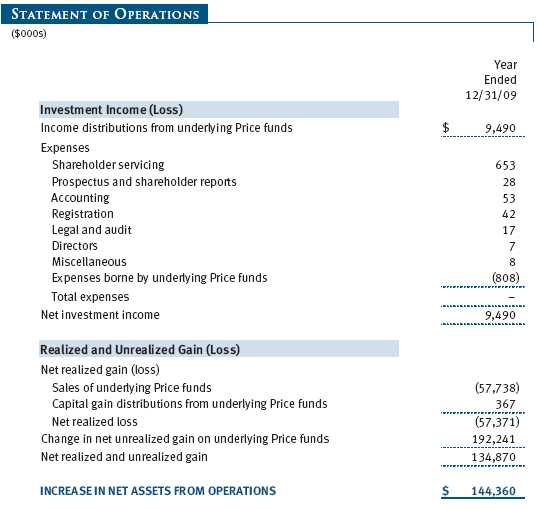
The accompanying notes are an integral part of these financial statements.
T. ROWE PRICE SPECTRUM GROWTH FUND
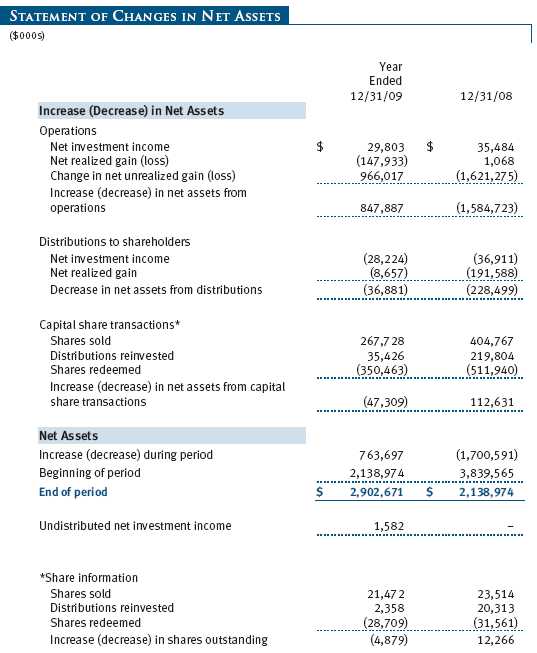
The accompanying notes are an integral part of these financial statements.
T. ROWE PRICE SPECTRUM INCOME FUND
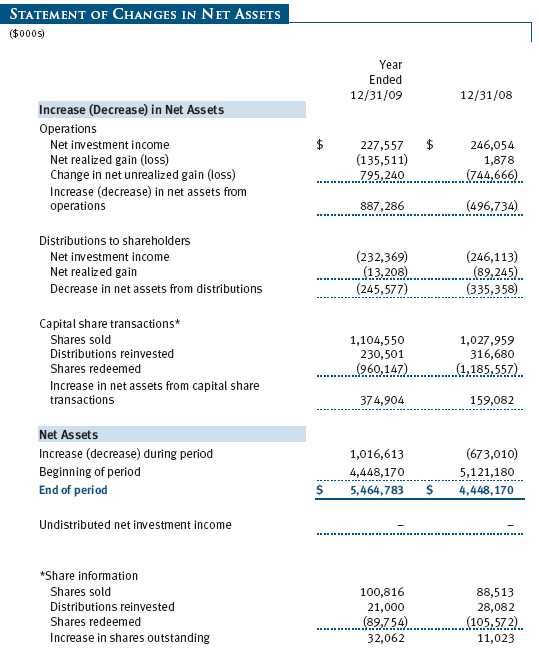
The accompanying notes are an integral part of these financial statements.
T. ROWE PRICE SPECTRUM INTERNATIONAL FUND
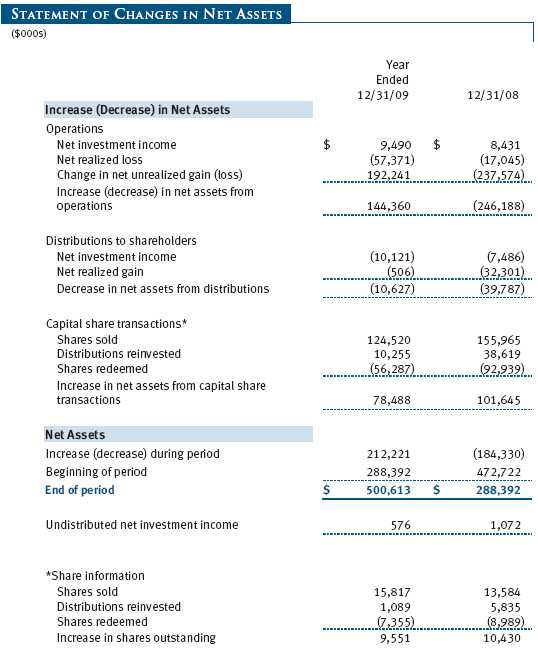
The accompanying notes are an integral part of these financial statements.
| NOTES TO FINANCIAL STATEMENTS |
T. Rowe Price Spectrum Fund, Inc. (the corporation), is registered under the Investment Company Act of 1940 (the 1940 Act) as a nondiversified, open-end management investment company. Spectrum Growth Fund, Spectrum Income Fund, and Spectrum International Fund (collectively, the Spectrum Funds) are three portfolios established by the corporation. Spectrum Growth and Spectrum Income commenced operations on June 29, 1990, and Spectrum International commenced operations on December 31, 1996.
Each Spectrum Fund diversifies its assets within set limits among specific underlying T. Rowe Price funds (underlying Price funds). Spectrum Growth seeks long-term capital appreciation and growth of income with current income a secondary objective. Spectrum Income seeks a high level of current income with moderate share price fluctuation. Spectrum International seeks long-term capital appreciation.
NOTE 1 - SIGNIFICANT ACCOUNTING POLICIES
Basis of Preparation The accompanying financial statements were prepared in accordance with accounting principles generally accepted in the United States of America (GAAP), which require the use of estimates made by fund management. Fund management believes that estimates and valuations of the underlying Price funds are appropriate; however, actual results may differ from those estimates, and the valuations reflected in the accompanying financial statements may differ from the value ultimately received upon sale of the underlying Price funds. Further, fund management believes that no events have occurred between December 31, 2009, the date of this report, and February 25, 2010, the date of issuance of the financial statements, that require adjustment of, or disclosure in, the accompanying financial statements.
Investment Transactions, Investment Income, and Distributions Income and expenses are recorded on the accrual basis. Income and capital gain distributions from the underlying Price funds are recorded on the ex-dividend date. Purchases and sales of the underlying Price funds are accounted for on the trade date. Gains and losses realized on sales of the underlying Price funds are reported on the identified cost basis. Distributions to the Spectrum Funds’ shareholders are recorded on the ex-dividend date. Income distributions are declared by Spectrum Income on a daily basis and paid monthly. Income distributions are declared and paid by Spectrum Growth and Spectrum International on an annual basis. Capital gain distributions, if any, are generally declared and paid by each fund annually.
Redemption Fees A 2% fee is assessed on redemptions of Spectrum International shares held for 90 days or less to deter short-term trading and to protect the interests of long-term shareholders. Redemption fees are withheld from proceeds that shareholders receive from the sale or exchange of fund shares and are paid to the fund. Redemption fees received by Spectrum International are allocated to each underlying Price fund in proportion to the average daily value of its shares owned by the fund. Accordingly, redemption fees have no effect on the net assets of Spectrum International.
NOTE 2 - VALUATION
Each fund’s investments are reported at fair value as defined under GAAP. Each fund values its investments and computes its net asset value per share at the close of the New York Stock Exchange (NYSE), normally 4 p.m. ET, each day that the NYSE is open for business. Investments in the underlying Price funds are valued at their closing net asset value per share on the day of valuation. Investments for which these valuation procedures are inappropriate or are deemed not to reflect fair value are stated at fair value as determined in good faith by the T. Rowe Price Valuation Committee, established by the funds’ Board of Directors.
Various inputs are used to determine the value of investments. These inputs are summarized in the three broad levels listed below:
Level 1 – quoted prices in active markets for identical securities
Level 2 – observable inputs other than Level 1 quoted prices (including, but not limited to, quoted prices for similar securities, interest rates, prepayment speeds, and credit risk)
Level 3 – unobservable inputs
Observable inputs are those based on market data obtained from sources independent of the Spectrum Funds, and unobservable inputs reflect the Spectrum Funds’ own assumptions based on the best information available. The input levels are not necessarily an indication of the risk or liquidity associated with investments at that level. On December 31, 2009, all investments in the underlying Price funds were classified as Level 1, based on the inputs used to determine their values.
NOTE 3 - INVESTMENTS IN UNDERLYING PRICE FUNDS
Purchases and sales of the underlying Price funds during the year ended December 31, 2009, were as follows:

NOTE 4 - FEDERAL INCOME TAXES
No provision for federal income taxes is required since each fund intends to continue to qualify as a regulated investment company under Subchapter M of the Internal Revenue Code and distribute to shareholders all of its taxable income and gains. Distributions determined in accordance with federal income tax regulations may differ in amount or character from net investment income and realized gains for financial reporting purposes. Financial reporting records are adjusted for permanent book/tax differences to reflect tax character but are not adjusted for temporary differences.
Each fund files U.S. federal, state, and local tax returns as required. Each fund’s tax returns are subject to examination by the relevant tax authorities until expiration of the applicable statute of limitations, which is generally three years after filing of the tax return but could be longer in certain circumstances.
For Spectrum International, reclassifications from paid-in capital relate primarily to the tax treatment of cash received from certain regulatory settlements. For Spectrum Income, reclassifications between income and gain relate primarily to the character of distributions from the underlying Price funds. For the year ended December 31, 2009, the following reclassifications were recorded to reflect tax character; the reclassifications had no impact on results of operations or net assets:

Distributions during the year ended December 31, 2009, were characterized for tax purposes as follows:

Distributions during the prior year ended December 31, 2008, were characterized for tax purposes as follows:

At December 31, 2009, the tax-basis costs of investments and components of net assets were as follows:
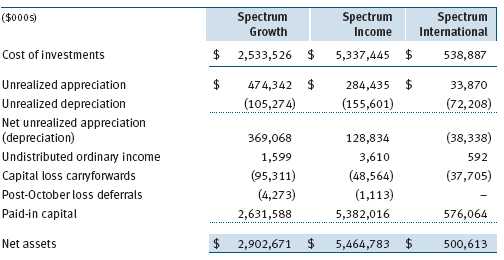
The difference between book-basis and tax-basis net unrealized appreciation (depreciation) is attributable to the deferral of losses from wash sales for tax purposes. Each fund intends to retain realized gains to the extent of available capital loss carryforwards. Spectrum Growth’s unused capital loss carryforwards as of December 31, 2009, all expire in 2017; Spectrum Income’s unused capital loss carryforwards all expire in 2017; and Spectrum International’s unused capital loss carryforwards expire: $665,000 in 2016 and $37,040,000 in 2017. In accordance with federal income tax regulations applicable to investment companies, recognition of capital losses on certain transactions realized between November 1 and the Spectrum funds’ year-end is deferred for tax purposes until the subsequent year (post-October loss deferrals); however, such losses are included in realized gain/loss reflected on the accompanying financial statements.
NOTE 5 - RELATED PARTIES
T. Rowe Price Associates, Inc. (Price Associates), a wholly owned subsidiary of T. Rowe Price Group, Inc., is the investment manager for Spectrum Growth and Spectrum Income, and also serves as manager for the domestic underlying Price funds. T. Rowe Price International, Inc. (Price International), a wholly owned subsidiary of Price Associates, is the investment manager for Spectrum International and also serves as manager for the international underlying Price funds. Pursuant to various service agreements, Price Associates and its wholly owned subsidiaries provide shareholder servicing and administrative, transfer and dividend disbursing, accounting, marketing, and certain other services to the Spectrum Funds. Certain officers and directors of the Spectrum Funds are also officers and directors of Price Associates and its subsidiaries, and of the underlying Price funds.
The Spectrum Funds pay no management fees; however, Price Associates and Price International receive management fees from the underlying Price funds. The Spectrum Funds operate in accordance with the investment management and special servicing agreements between and among the corporation, the underlying Price funds, Price Associates, and, in the case of Spectrum International, Price International. Pursuant to these agreements, expenses associated with the operation of the Spectrum Funds are borne by each underlying Price fund to the extent of estimated savings to it and in proportion to the average daily value of its shares owned by the Spectrum Funds. Therefore, each Spectrum Fund operates at a zero expense ratio. However, each Spectrum Fund indirectly bears its proportionate share of the management fees and operating costs of the underlying Price funds in which it invests.
The Spectrum Funds do not invest in the underlying Price funds for the purpose of exercising management or control; however, investments by the Spectrum Funds may represent a significant portion of an underlying Price fund’s net assets. At December 31, 2009, Spectrum Growth and Spectrum International each held less than 25% of the outstanding shares of any underlying Price fund; Spectrum Income held approximately 51% of the outstanding shares of the Corporate Income Fund and 37% of the GNMA Fund.
Additionally, Spectrum Income is one of several mutual funds in which certain college savings plans managed by Price Associates may invest. Shareholder servicing costs associated with each college savings plan are allocated to Spectrum Income in proportion to the average daily value of its shares owned by the college savings plan and, in turn, are borne by the underlying Price funds in accordance with the terms of the investment management and special servicing agreements. At December 31, 2009, approximately 19% of the outstanding shares of Spectrum Income were held by the college savings plans.
As of December 31, 2009, T. Rowe Price Group, Inc., and/or its wholly owned subsidiaries owned 2,061,790 shares of Spectrum Growth, representing 1% of the fund’s net assets.
| REPORT OF INDEPENDENT REGISTERED PUBLIC ACCOUNTING FIRM |
To the Board of Directors of T. Rowe Price Spectrum Fund, Inc. and
Shareholders of T. Rowe Price Spectrum Growth Fund, Spectrum Income Fund, and
Spectrum International Fund
In our opinion, the accompanying statements of assets and liabilities, including the schedules of investments, and the related statements of operations and of changes in net assets and the financial highlights present fairly, in all material respects, the financial position of T. Rowe Price Spectrum Growth Fund, Spectrum Income Fund, and Spectrum International Fund (the funds comprising T. Rowe Price Spectrum Fund, Inc., hereafter referred to as the “Funds”) at December 31, 2009, the results of their operations for the year then ended, the changes in their net assets for each of the two years in the period then ended and the financial highlights for each of the five years in the period then ended, in conformity with accounting principles generally accepted in the United States of America. These financial statements and financial highlights (hereafter referred to as “financial statements”) are the responsibility of the Funds’ management; our responsibility is to express an opinion on these financial statements based on our audits. We conducted our audits of these financial statements in accordance with the standards of the Public Company Accounting Oversight Board (United States). Those standards require that we plan and perform the audit to obtain reasonable assurance about whether the financial statements are free of material misstatement. An audit includes examining, on a test basis, evidence supporting the amounts and disclosures in the financial statements, assessing the accounting principles used and significant estimates made by management, and evaluating the overall financial statement presentation. We believe that our audits, which included confirmation of the underlying funds at December 31, 2009 by correspondence with the transfer agent, provide a reasonable basis for our opinion.
PricewaterhouseCoopers LLP
Baltimore, Maryland
February 25, 2010
| TAX INFORMATION (UNAUDITED) FOR THE TAX YEAR ENDED 12/31/09 |
SPECTRUM GROWTH FUND
We are providing this information as required by the Internal Revenue Code. The amounts shown may differ from those elsewhere in this report because of differences between tax and financial reporting requirements.
The fund’s distributions to shareholders included:
• $1,882,000 from short-term capital gains
• $6,775,000 from long-term capital gains, subject to the 15% rate gains category.
For taxable non-corporate shareholders, $28,851,000 of the fund’s income represents qualified dividend income subject to the 15% rate category.
For corporate shareholders, $18,945,000 of the fund’s income qualifies for the dividends-received deduction.
SPECTRUM INCOME FUND
We are providing this information as required by the Internal Revenue Code. The amounts shown may differ from those elsewhere in this report because of differences between tax and financial reporting requirements.
The fund’s distributions to shareholders included:
• $10,481,000 from short-term capital gains
• $7,539,000 from long-term capital gains, subject to the 15% rate gains category.
For taxable non-corporate shareholders, $17,392,000 of the fund’s income represents qualified dividend income subject to the 15% rate category.
For corporate shareholders, $17,392,000 of the fund’s income qualifies for the dividends-received deduction.
SPECTRUM INTERNATIONAL FUND
We are providing this information as required by the Internal Revenue Code. The amounts shown may differ from those elsewhere in this report because of differences between tax and financial reporting requirements.
The fund’s distributions to shareholders included $506,000 from short-term capital gains.
For taxable non-corporate shareholders, $9,090,000 of the fund’s income represents qualified dividend income subject to the 15% rate category.
For corporate shareholders, $56,000 of the fund’s income qualifies for the dividends-received deduction.
| INFORMATION ON PROXY VOTING POLICIES, PROCEDURES, AND RECORDS |
A description of the policies and procedures used by T. Rowe Price funds and portfolios to determine how to vote proxies relating to portfolio securities is available in each fund’s Statement of Additional Information, which you may request by calling 1-800-225-5132 or by accessing the SEC’s Web site, www.sec.gov. The description of our proxy voting policies and procedures is also available on our Web site, www.troweprice.com. To access it, click on the words “Our Company” at the top of our corporate homepage. Then, when the next page appears, click on the words “Proxy Voting Policies” on the left side of the page.
Each fund’s most recent annual proxy voting record is available on our Web site and through the SEC’s Web site. To access it through our Web site, follow the directions above, then click on the words “Proxy Voting Records” on the right side of the Proxy Voting Policies page.
| HOW TO OBTAIN QUARTERLY PORTFOLIO HOLDINGS |
The fund files a complete schedule of portfolio holdings with the Securities and Exchange Commission for the first and third quarters of each fiscal year on Form N-Q. The fund’s Form N-Q is available electronically on the SEC’s Web site (www.sec.gov); hard copies may be reviewed and copied at the SEC’s Public Reference Room, 450 Fifth St. N.W., Washington, DC 20549. For more information on the Public Reference Room, call 1-800-SEC-0330.
| ABOUT THE FUND’S DIRECTORS AND OFFICERS |
Your funds are governed by a Board of Directors (Board) that meets regularly to review a wide variety of matters affecting the funds, including performance, investment programs, compliance matters, advisory fees and expenses, service providers, and other business affairs. The Board elects the funds’ officers, who are listed in the final table. At least 75% of Board members are independent of T. Rowe Price Associates, Inc. (T. Rowe Price), and T. Rowe Price International, Inc. (T. Rowe Price International); “inside” or “interested” directors are employees or officers of T. Rowe Price. The business address of each director and officer is 100 East Pratt Street, Baltimore, Maryland 21202. The Statement of Additional Information includes additional information about the directors and is available without charge by calling a T. Rowe Price representative at 1-800-225-5132.
| Independent Directors | |
| |
| Name | |
| (Year of Birth) | Principal Occupation(s) During Past Five Years and Directorships of |
| Year Elected* | Other Public Companies |
| | |
| William R. Brody, M.D., | President and Trustee, Salk Institute for Biological Studies (2009 |
| Ph.D. | to present); Director, Novartis, Inc. (2009 to present); Director, IBM |
| (1944) | (2007 to present); President and Trustee, Johns Hopkins University |
| 2009 | (1996 to 2009); Chairman of Executive Committee and Trustee, |
| | Johns Hopkins Health System (1996 to 2009) |
| | |
| Jeremiah E. Casey | Director, National Life Insurance (2001 to 2005); Director, The Rouse |
| (1940) | Company, real estate developers (1990 to 2004) |
| 2005 | |
| | |
| Anthony W. Deering | Chairman, Exeter Capital, LLC, a private investment firm (2004 |
| (1945) | to present); Director, Under Armour (2008 to present); Director, |
| 2001 | Vornado Real Estate Investment Trust (2004 to present); Director, |
| | Mercantile Bankshares (2002 to 2007); Member, Advisory Board, |
| | Deutsche Bank North America (2004 to present); Director, Chairman |
| | of the Board, and Chief Executive Officer, The Rouse Company, real |
| | estate developers (1997 to 2004) |
| | |
| Donald W. Dick, Jr. | Principal, EuroCapital Advisors, LLC, an acquisition and manage- |
| (1943) | ment advisory firm (1995 to present) |
| 1999 | |
| | |
| Karen N. Horn | Director, Eli Lilly and Company (1987 to present); Director, Simon |
| (1943) | Property Group (2004 to present); Director, Norfolk Southern (2008 |
| 2003 | to present); Director, Georgia Pacific (2004 to 2005) |
| | |
| Theo C. Rodgers | President, A&R Development Corporation (1977 to present) |
| (1941) | |
| 2005 | |
| | |
John G. Schreiber | Owner/President, Centaur Capital Partners, Inc., a real estate invest- | | (1946) | ment company (1991 to present); Partner, Blackstone Real Estate |
| 2001 | Advisors, L.P. (1992 to present) |
| | |
| Mark R. Tercek | President and Chief Executive Officer, The Nature Conservancy (2008 |
| (1957) | to present); Managing Director, The Goldman Sachs Group, Inc. |
| 2009 | (1984 to 2008) |
| |
| *Each independent director oversees 124 T. Rowe Price portfolios and serves until retirement, resignation, |
| or election of a successor. | |
| Inside Directors | |
| |
| Name | |
| (Year of Birth) | |
| Year Elected* | |
| [Number of T. Rowe Price | Principal Occupation(s) During Past Five Years and Directorships of |
| Portfolios Overseen] | Other Public Companies |
| | |
| Edward C. Bernard | Director and Vice President, T. Rowe Price; Vice Chairman of the |
| (1956) | Board, Director, and Vice President, T. Rowe Price Group, Inc.; |
| 2006 | Chairman of the Board, Director, and President, T. Rowe Price |
| [124] | Investment Services, Inc.; Chairman of the Board and Director, |
| | T. Rowe Price Global Asset Management Limited, T. Rowe Price |
| | Global Investment Services Limited, T. Rowe Price Retirement |
| | Plan Services, Inc., T. Rowe Price Savings Bank, and T. Rowe Price |
| | Services, Inc.; Director, T. Rowe Price International, Inc.; Chief |
| | Executive Officer, Chairman of the Board, Director, and President, |
| | T. Rowe Price Trust Company; Chairman of the Board, all funds |
| | |
| Brian C. Rogers, CFA, CIC | Chief Investment Officer, Director, and Vice President, T. Rowe Price; |
| (1955) | Chairman of the Board, Chief Investment Officer, Director, and Vice |
| 2006 | President, T. Rowe Price Group, Inc.; Vice President, T. Rowe Price |
| [69] | Trust Company; Vice President, Spectrum Funds |
| |
| *Each inside director serves until retirement, resignation, or election of a successor. |
| Officers | |
| |
| Name (Year of Birth) | |
| Position Held With Spectrum Funds | Principal Occupation(s) |
| | |
| Christopher D. Alderson (1962) | Chief Executive Officer, Director, and President, |
| Executive Vice President | T. Rowe Price International, Inc.; Vice President, |
| | T. Rowe Price Global Investment Services |
| | Limited and T. Rowe Price Group, Inc. |
| | |
| Mark C.J. Bickford-Smith (1962) | Vice President, T. Rowe Price Group, Inc., and |
| Vice President | T. Rowe Price International, Inc. |
| | |
| Roger L. Fiery III, CPA (1959) | Vice President, T. Rowe Price, T. Rowe Price |
| Vice President | Group, Inc., T. Rowe Price International, Inc., |
| | and T. Rowe Price Trust Company |
| | |
| John R. Gilner (1961) | Chief Compliance Officer and Vice President, |
| Chief Compliance Officer | T. Rowe Price; Vice President, T. Rowe Price |
| | Group, Inc., and T. Rowe Price Investment |
| | Services, Inc. |
| | |
| Gregory S. Golczewski (1966) | Vice President, T. Rowe Price and T. Rowe Price |
| Vice President | Trust Company |
| | |
| Gregory K. Hinkle, CPA (1958) | Vice President, T. Rowe Price, T. Rowe Price |
| Treasurer | Group, Inc., and T. Rowe Price Trust Company; |
| | formerly Partner, PricewaterhouseCoopers LLP |
| | (to 2007) |
| | |
| John H. Laporte, CFA (1945) | Vice President, T. Rowe Price, T. Rowe Price |
| Executive Vice President | Group, Inc., and T. Rowe Price Trust Company |
| | |
| Patricia B. Lippert (1953) | Assistant Vice President, T. Rowe Price and |
| Secretary | T. Rowe Price Investment Services, Inc. |
| | |
| Raymond A. Mills, Ph.D., CFA (1960) | Vice President, T. Rowe Price, T. Rowe Price |
| Vice President | Group, Inc., T. Rowe Price International, Inc., |
| | and T. Rowe Price Trust Company |
| | |
| Edmund M. Notzon III, Ph.D., CFA (1945) | Vice President, T. Rowe Price, T. Rowe Price |
| President | Global Investment Services Limited, T. Rowe |
| | Price Group, Inc., T. Rowe Price Investment |
| | Services, Inc., and T. Rowe Price Trust Company |
| | |
David Oestreicher (1967) | Director and Vice President, T. Rowe Price | | Vice President | Investment Services, Inc., T. Rowe Price Trust |
| | Company, and T. Rowe Price Services, Inc.; Vice |
| | President, T. Rowe Price, T. Rowe Price Global |
| | Asset Management Limited, T. Rowe Price |
| | Global Investment Services Limited, T. Rowe |
| | Price Group, Inc., T. Rowe Price International, |
| | Inc., and T. Rowe Price Retirement Plan |
| | Services, Inc. |
| | |
| Deborah D. Seidel (1962) | Vice President, T. Rowe Price, T. Rowe Price |
| Vice President | Investment Services, Inc., and T. Rowe Price |
| | Services, Inc. |
| | |
| Charles M. Shriver, CFA (1967) | Vice President, T. Rowe Price, T. Rowe Price |
| Vice President | Global Investment Services Limited, and |
| | T. Rowe Price Group, Inc. |
| | |
| Robert W. Smith (1961) | Vice President, T. Rowe Price, T. Rowe Price |
| Vice President | Group, Inc., and T. Rowe Price Trust Company |
| | |
| Julie L. Waples (1970) | Vice President, T. Rowe Price |
| Vice President | |
| |
| Unless otherwise noted, officers have been employees of T. Rowe Price or T. Rowe Price International for |
| at least five years. | |
Item 2. Code of Ethics.
The registrant has adopted a code of ethics, as defined in Item 2 of Form N-CSR, applicable to its principal executive officer, principal financial officer, principal accounting officer or controller, or persons performing similar functions. A copy of this code of ethics is filed as an exhibit to this Form N-CSR. No substantive amendments were approved or waivers were granted to this code of ethics during the period covered by this report.
Item 3. Audit Committee Financial Expert.
The registrant’s Board of Directors/Trustees has determined that Mr. Anthony W. Deering qualifies as an audit committee financial expert, as defined in Item 3 of Form N-CSR. Mr. Deering is considered independent for purposes of Item 3 of Form N-CSR.
Item 4. Principal Accountant Fees and Services.
(a) – (d) Aggregate fees billed to the registrant for the last two fiscal years for professional services rendered by the registrant’s principal accountant were as follows:

Audit fees include amounts related to the audit of the registrant’s annual financial statements and services normally provided by the accountant in connection with statutory and regulatory filings. Audit-related fees include amounts reasonably related to the performance of the audit of the registrant’s financial statements and specifically include the issuance of a report on internal controls and, if applicable, agreed-upon procedures related to fund acquisitions. Tax fees include amounts related to services for tax compliance, tax planning, and tax advice. The nature of these services specifically includes the review of distribution calculations and the preparation of Federal, state, and excise tax returns. All other fees include the registrant’s pro-rata share of amounts for agreed-upon procedures in conjunction with service contract approvals by the registrant’s Board of Directors/Trustees.
(e)(1) The registrant’s audit committee has adopted a policy whereby audit and non-audit services performed by the registrant’s principal accountant for the registrant, its investment adviser, and any entity controlling, controlled by, or under common control with the investment adviser that provides ongoing services to the registrant require pre-approval in advance at regularly scheduled audit committee meetings. If such a service is required between regularly scheduled audit committee meetings, pre-approval may be authorized by one audit committee member with ratification at the next scheduled audit committee meeting. Waiver of pre-approval for audit or non-audit services requiring fees of a de minimis amount is not permitted.
(2) No services included in (b) – (d) above were approved pursuant to paragraph (c)(7)(i)(C) of Rule 2-01 of Regulation S-X.
(f) Less than 50 percent of the hours expended on the principal accountant’s engagement to audit the registrant’s financial statements for the most recent fiscal year were attributed to work performed by persons other than the principal accountant’s full-time, permanent employees.
(g) The aggregate fees billed for the most recent fiscal year and the preceding fiscal year by the registrant’s principal accountant for non-audit services rendered to the registrant, its investment adviser, and any entity controlling, controlled by, or under common control with the investment adviser that provides ongoing services to the registrant were $1,879,000 and $1,922,000, respectively.
(h) All non-audit services rendered in (g) above were pre-approved by the registrant’s audit committee. Accordingly, these services were considered by the registrant’s audit committee in maintaining the principal accountant’s independence.
Item 5. Audit Committee of Listed Registrants.
Not applicable.
Item 6. Investments.
(a) Not applicable. The complete schedule of investments is included in Item 1 of this Form N-CSR.
(b) Not applicable.
Item 7. Disclosure of Proxy Voting Policies and Procedures for Closed-End Management Investment Companies.
Not applicable.
Item 8. Portfolio Managers of Closed-End Management Investment Companies.
Not applicable.
Item 9. Purchases of Equity Securities by Closed-End Management Investment Company and Affiliated Purchasers.
Not applicable.
Item 10. Submission of Matters to a Vote of Security Holders.
Not applicable.
Item 11. Controls and Procedures.
(a) The registrant’s principal executive officer and principal financial officer have evaluated the registrant’s disclosure controls and procedures within 90 days of this filing and have concluded that the registrant’s disclosure controls and procedures were effective, as of that date, in ensuring that information required to be disclosed by the registrant in this Form N-CSR was recorded, processed, summarized, and reported timely.
(b) The registrant’s principal executive officer and principal financial officer are aware of no change in the registrant’s internal control over financial reporting that occurred during the registrant’s second fiscal quarter covered by this report that has materially affected, or is reasonably likely to materially affect, the registrant’s internal control over financial reporting.
Item 12. Exhibits.
(a)(1) The registrant’s code of ethics pursuant to Item 2 of Form N-CSR is attached.
(2) Separate certifications by the registrant's principal executive officer and principal financial officer, pursuant to Section 302 of the Sarbanes-Oxley Act of 2002 and required by Rule 30a-2(a) under the Investment Company Act of 1940, are attached.
(3) Written solicitation to repurchase securities issued by closed-end companies: not applicable.
(b) A certification by the registrant's principal executive officer and principal financial officer, pursuant to Section 906 of the Sarbanes-Oxley Act of 2002 and required by Rule 30a-2(b) under the Investment Company Act of 1940, is attached.
| | |
SIGNATURES |
| |
| | Pursuant to the requirements of the Securities Exchange Act of 1934 and the Investment |
| Company Act of 1940, the registrant has duly caused this report to be signed on its behalf by the |
| undersigned, thereunto duly authorized. |
| |
| T. Rowe Price Spectrum Fund, Inc. |
| |
| |
| |
| By | /s/ Edward C. Bernard |
| | Edward C. Bernard |
| | Principal Executive Officer |
| |
| Date | February 25, 2010 |
| |
| |
| |
| | Pursuant to the requirements of the Securities Exchange Act of 1934 and the Investment |
| Company Act of 1940, this report has been signed below by the following persons on behalf of |
| the registrant and in the capacities and on the dates indicated. |
| |
| |
| By | /s/ Edward C. Bernard |
| | Edward C. Bernard |
| | Principal Executive Officer |
| |
| Date | February 25, 2010 |
| |
| |
| |
| By | /s/ Gregory K. Hinkle |
| | Gregory K. Hinkle |
| | Principal Financial Officer |
| |
| Date | February 25, 2010 |



















































